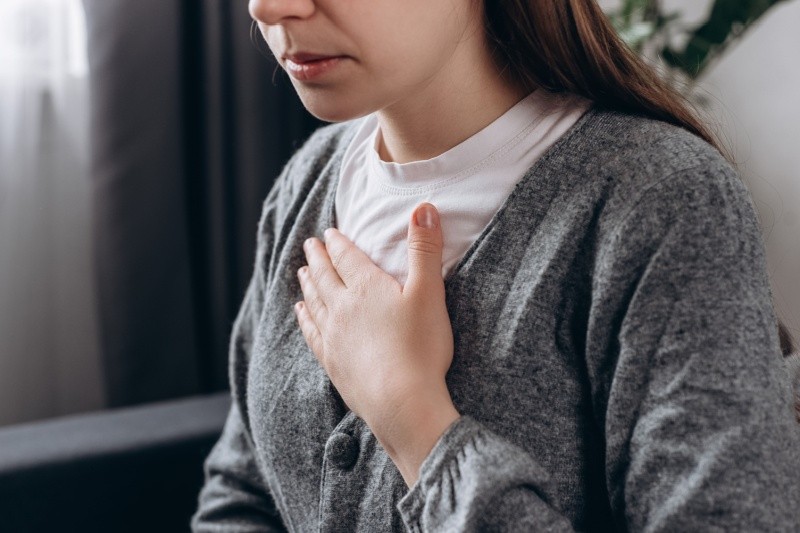When you think of a हार्ट अटैक, classic symptoms likely jump to mind: chest pain that radiates to your left arm, difficulty breathing, and collapsing to the floor, followed by a frantic ambulance ride to the emergency room. Sometimes, a heart attack presents itself in this way. But other times, and especially for women, the signs of a heart attack can be much subtler. Some women don’t even know they’ve had a heart attack or other heart problem until they get checked out for a seemingly unrelated symptom.
इनके बारे में जानें:
- Recognizing subtle symptoms of heart disease in women
- Why women may experience different symptoms
- Steps to protect your heart health
Recognizing subtle symptoms of heart disease in women
The scary facts are that more than 44 million women are affected by heart disease, and cardiovascular disease and stroke are responsible for one in three deaths among women. That’s one death every 80 seconds. The most important thing to do is to know the subtle symptoms of heart disease in women.
Chest pain and discomfort

Chest pain is discomfort or pain you feel anywhere along the front of your body between your neck and upper abdomen. Chest discomfort or pressure, described as feeling tightness, squeezing, or aching in the chest, is one of the most common symptoms during a heart attack in women. It includes chest pain and pain that radiates down the shoulder and arm. Stress to your heart muscle is sometimes felt in your back instead. If you have a backache unrelated to an obvious injury, it could be your heart. Instead of sharp or shooting pains, you may feel a dull ache throughout your chest.
थकान और कमज़ोरी
थकान is a lingering tiredness that is constant and limiting. With fatigue, you have unexplained, persistent, and relapsing exhaustion. Symptoms of fatigue include lack of energy, drowsiness, difficulty thinking, and loss of motivation to do activities. Severe fatigue, also known as ‘vital fatigue’, or fatigue that interferes with daily activities, something as simple as making your bed, and weakness can be other subtle symptoms of heart disease in women.
सांस फूलना
Feeling shortness of breath during activities that normally wouldn’t cause you to breathe hard is a potential symptom of a heart attack, as is a general increase in fatigue. It is an uncomfortable feeling of not being able to breathe well enough. It can occur gradually or suddenly, and it feels like you are running out of air or can’t breathe deeply enough. It can happen when वॉकिंग, climbing stairs, sitting still, or doing daily activities.
Digestive upsets
Digestive upset can be a subtle symptom of heart disease in women, along with other symptoms:
- जी मिचलाने की समस्या or vomiting are early signs of a heart attack in women. It has many causes, but it may also precede a heart attack for some women. You may feel sick to your stomach or throw up
- Heartburn (a burning feeling in the chest or upper abdomen that’s caused by stomach acid flowing up into the esophagus) in the form of indigestion or upset stomach
- भूख न लगना
Jaw and shoulder pain
Pain from a heart attack can also radiate to your neck, jaw, throat, upper belly, shoulder, and back instead of being felt in your chest. Jaw pain is a common symptom easily missed as a toothache or tension. It can feel like aching or general discomfort in the area. Shoulder or arm pain may feel like tingling, pins-and-needles, dull ache, weakness, heaviness, or a crushing feeling more like discomfort rather than pain. During a heart attack, it can come and go, and present before and during a cardiac arrest.
Swelling
Swelling in the legs, ankles, feet, or abdomen can be a sign of heart failure or fluid retention related to heart disease.
Why women may experience different symptoms
Women face unique risks, largely due to differences in anatomy and hormones. They are more likely to have other heart attack symptoms along with chest pain, and they have a higher chance of developing symptoms from heart failure. Women have smaller hearts and narrower blood vessels than men, which can lead to different ways that heart disease progresses. They are more likely to develop heart disease in the smaller arteries of the heart, which can make it harder to identify and treat. There’s no clear explanation for why heart attack symptoms appear differently in women than they do in men. A few factors may play a role. In women, heart disease tends to affect the smaller cardiac vessels more often than in men. Tight artery blockages are not as common in women as in men. Women’s vessels are sometimes smaller, and the vessel walls often stiffer. However, whether these factors are the underlying cause of the variation in symptoms between men and women is not well understood.
Steps to protect your heart health
Follow the steps mentioned below to protect your heart health.
Regular checkups and screenings

Get regular health screening tests. High blood pressure and हाई कोलेस्ट्रॉल can damage the heart and blood vessels. But if you don’t get checked for these conditions, you likely won’t know whether you have them. Regular screening tests can tell you where you stand and whether you need to take action.
Healthy lifestyle changes
Make the following healthy lifestyle changes:
Exercise regularly: Aim for at least 30 to 60 minutes of daily activity.
Eat a heart-healthy diet: Include vegetables and fruits, beans, low-fat or fat-free dairy foods, whole grains, and healthy fats such as olive oil and avocado.
Manage stress: Healthy tactics include physical activity, relaxation exercises, mindfulness, yoga, and meditation.
Get quality sleep: Aim for seven to eight hours of sleep per night.
Avoid smoking and alcohol: Chemicals in tobacco can damage the heart and blood vessels.
Know your family history
Knowing your family history can help you protect your heart health by identifying risk factors and taking steps to reduce them. Ask family members about their health history, including whether they have had a heart attack, stroke, or been diagnosed with heart disease. You can also ask about high blood pressure, high cholesterol, or a family history of congenital heart disease. Share your family health history with your doctor, who can help you identify risk factors and develop a plan to reduce them.
Heart disease in women often presents with subtle symptoms that can easily be mistaken for less serious conditions. Recognizing these warning signs as mentioned above can be life-saving. Women must be proactive about their heart health, pay attention to their bodies, and seek medical advice if something feels off.
Stay tuned to the Activ Living Community. Keep up to date with the latest health tips and trends through expert videos, podcasts, articles, and much more on पोषण, फिटनेस, सचेतन, और लाइफस्टाइल से जुड़ी बीमारियां like Asthma, Blood Pressure, Cholesterol, and Diabetes. Activ Living ke saath sahi sehat ki shuruat ABHI karo.
You may also be interested in the following blogs:
- 5 Tips To Stay Heart-Healthy At Work
- Change For The Better: 6 Lifestyle Adjustments To Prioritize Women’s Health
Popular Searches
How to lower blood pressure | Fruits good for liver | Unhealthy foods | रागी के लाभ | बेसल मेटाबोलिक रेट | हाई ब्लड प्रेशर के लिए एक्यूप्रेशर पॉइंट्स | Ayurvedic medicine for blood pressure | How to control cholesterol at home | Homeopathy for Asthma | Biological Age | Home remedies for TB | Natural beta blockers | Negative effects of internet | Types of walking | ब्लड प्रेशर कैलकुलेटर | ब्लड शुगर कैलकुलेटर | BMI कैलकुलेटर





 1800-270-7000
1800-270-7000








